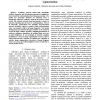Free Online Productivity Tools
i2Speak
i2Symbol
i2OCR
iTex2Img
iWeb2Print
iWeb2Shot
i2Type
iPdf2Split
iPdf2Merge
i2Bopomofo
i2Arabic
i2Style
i2Image
i2PDF
iLatex2Rtf
Sci2ools
IJCNN
2006
IEEE
2006
IEEE
Oscillatory Network for Synchronization-Based Adaptive Image Segmentation
— Oscillatory network model with controllable oscillator dynamics and self-organized dynamical coupling has been created for synchronization-based image processing. The model was previously obtained via reduction from a biologically motivated oscillatory model of the primary visual cortex. The reduced network model performance consists in network relaxation into the state of synchronization. The set of internally synchronized but mutually desynchronized network ensembles (clusters), arising at final synchronization state, corresponds to full set of image fragments. New model developments, presented in the paper, include: a) the advanced
| Added | 11 Jun 2010 |
| Updated | 11 Jun 2010 |
| Type | Conference |
| Year | 2006 |
| Where | IJCNN |
| Authors | Eugene Grichuk, Margarita Kuzmina, Edward A. Manykin |
Comments (0)

